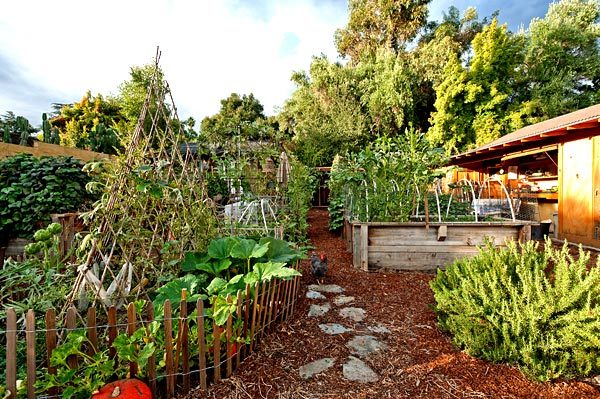|

Reduce garden labor with good design
By Urban Harvest
 Everyone who takes care of land is severely limited by the amount of labor they have to work the site. It makes a big difference whether you are one person, a multi-person household sharing the work, or if you are paying workers. And it makes a big difference where you have lots of time to work or only a little. Also the time you have isn’t constant: it varies depending on work schedules, how healthy you are, or whether you are traveling. Everyone who takes care of land is severely limited by the amount of labor they have to work the site. It makes a big difference whether you are one person, a multi-person household sharing the work, or if you are paying workers. And it makes a big difference where you have lots of time to work or only a little. Also the time you have isn’t constant: it varies depending on work schedules, how healthy you are, or whether you are traveling.
Other things being equal, if there is a lot of labor, your garden will thrive, and if there is not much labor, there are going to be problems. But why should "other things be equal?" With clever landscaping design, you can greatly reduce the amount of weekly labor.
The effort to conserve energy, materials and labor in landscape design is part of a design ap-proach known as permaculture. Permaculture is taught in Houston through Urban Harvest, for more details see Urban Harvest Permaculture
In permaculture, we make sector observations of the "wild energies" that flow through the landscape. These include wind, heat, light, fire, water, precipitation, animal life like squirrels or cats or stinkbugs, plants that move by runners or seed dispersal, and such unwelcome human-caused energies as trash scatter, chemical pollution, ozone, noise, pesticide sprays, and trespassing people.
Permaculturalists try to observe when these energies vary in strength (winter, evening, when we have a hurricane, rain storm), where they vary (on the north edge, by the road, under the eave on the south wall), and how objects in the landscape can affect these energies.
Energies can be channeled, funneled, diverted, blocked, netted, or sifted depending on what you want to do. If you want the energy, you might focus it or move it where you can use it, and if you don’t want it, block it, dissipate it, or move it where it will be less harmful. To do this, use plants or built materials shaped to accomplish this.
Look at the shapes of the objects in your landscape. Include a bird‘s eye view of the garden beds. Is your landscape suffering from too many rectangles and only a few boring shapes? Why?
Shape is just another way of saying edge-pattern. In nature, the most productive places are typically the edges between groupings of plants, or at the edges of ponds, rocky slopes, and meadows. The shape one chooses for a raised bed, a walk, patio, pond, or fruit orchard deter-mines what sort of edge it will have, how long the edge will be, whether various energies will move across that edge, and if so, how fast. The shortest edge for a given area is a circle, while the longest edge for an area is a shape with many indentations and peninsulas like a star or mandala.
So if you want to have a lot of edge -- perhaps for a bird-attracting pond -- pick a shape with lots of indentations and peninsulas. If you want to minimize infiltration of undesirables like Bermuda grass into a raised bed, minimize edge. Use a square or circular retaining frame, rather than a long skinny rectangle or freeform.
When we do permacultural design, we assemble patterns, and use them to alter the flow of sec-tor energies. This usually results in higher and more diverse overall yields, less cost, more efficient land use, and incidentally significantly less work. If you would like to find out more about permaculture classes, check out our Sustainable Living Through Permaculture class 1 which is Sunday, September 29th, 2pm - 6pm Sustainable Living Through Permaculture class 1.
This column is produced by Urban Harvest. Learn about gardening classes, community gardens and orchards, farmers markets and more at www.urbanharvest.org. This article was written by Bob Randall, Ph.D. who is now retired, is a co-founder and former executive director of Urban Harvest and the author of Year Round Vegetables, Fruits and Flowers for Metro-Houston. Con-tact him at http://yearroundgardening.wordpress.com/ . |
